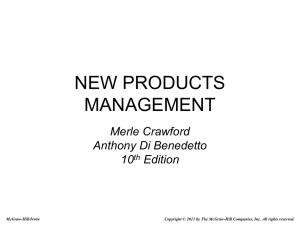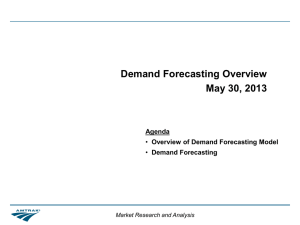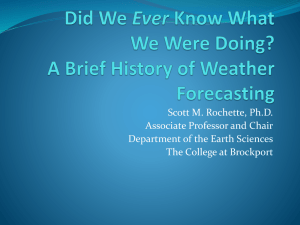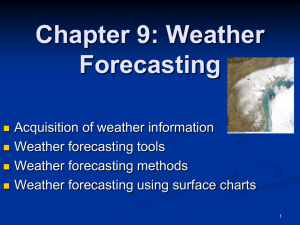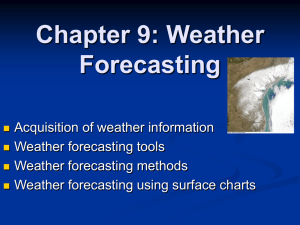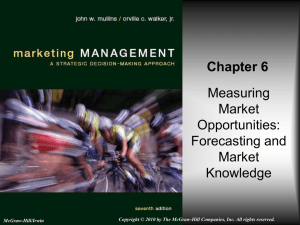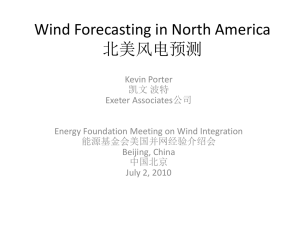Chapter 9
advertisement
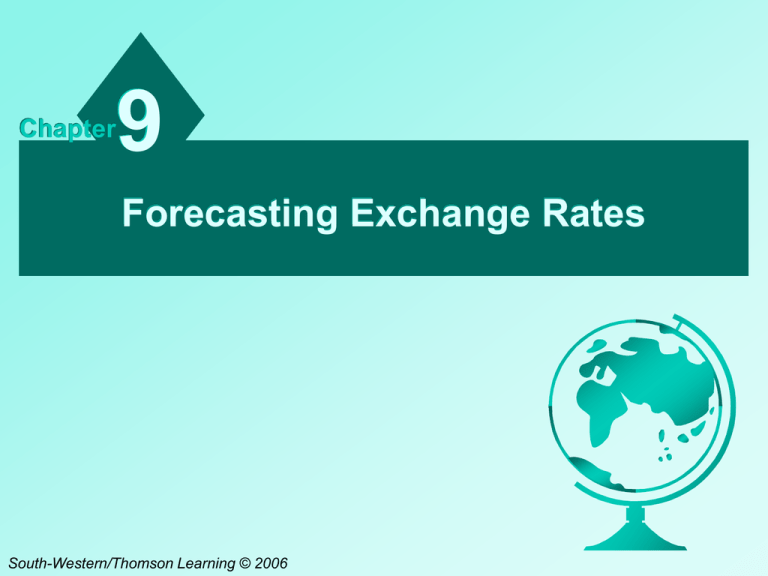
Chapter 9 Forecasting Exchange Rates South-Western/Thomson Learning © 2006 Corporate Motives for Forecasting Exchange Rates Decide whether to hedge foreign currency cash flows Forecasting exchange rates Decide whether to invest in foreign projects Dollar 1QA\ cash flows Decide whether foreign subsidiaries should remit earnings Decide whether to obtain financing in foreign currencies Value 1QA\ of the firm Cost of capital 9-2 Forecasting Techniques • The numerous methods available for forecasting exchange rates can be categorized into four general groups: technical, fundamental, market-based, and mixed. 9-3 Technical Forecasting • Technical forecasting involves the use of historical data to predict future values. ¤ E.g. time series models. • Speculators may find the models useful for predicting day-to-day movements. • However, since the models typically focus on the near future and rarely provide point or range estimates, they are of limited use to MNCs. 9-4 Fundamental Forecasting • In general, fundamental forecasting is limited by: ¤ ¤ ¤ ¤ the uncertain timing of the impact of the factors, the need to forecast factors that have an immediate impact on exchange rates, the omission of factors that are not easily quantifiable, and changes in the sensitivity of currency movements to each factor over time. 9-5 Market-Based Forecasting • Market-based forecasting uses market indicators to develop forecasts. • The current spot/forward rates are often used, since speculators will ensure that the current rates reflect the market expectation of the future exchange rate. • For long-term forecasting, the interest rates on risk-free instruments can be used under conditions of IRP. 9-6 Mixed Forecasting • Mixed forecasting refers to the use of a combination of forecasting techniques. • The actual forecast is a weighted average of the various forecasts developed. 9-7 Evaluation of Forecast Performance • An MNC that forecasts exchange rates should monitor its performance over time to determine whether its forecasting procedure is satisfactory. • One popular measure, the absolute forecast error as a percentage of the realized value, is defined as: | forecasted value – realized value | realized value 9-8 Absolute Forecast Errors over Time Using the Forward Rate as a Forecast for the British Pound 9-9 Evaluation of Forecast Performance • MNCs are likely to have more confidence in their forecasts as they measure their forecast error over time. • Forecast accuracy varies among currencies. A more stable currency can usually be more accurately predicted. • If the forecast errors are consistently positive or negative over time, then there is a bias in the forecasting procedure. 9 - 10 Forecast Bias over Time for the British Pound 9 - 11 Forecast Bias • The following regression model can be used to test for forecast bias: realized value = a0 + a1 Ft – 1 + m 9 - 12 Graphic Evaluation of Forecast Performance • If the points appear to be scattered evenly on both sides of the perfect forecast line, then the forecasts are said to be unbiased. • Note that a more thorough assessment can be conducted by separating the entire period into subperiods. 9 - 13 Forecast Bias in Different Subperiods for the British Pound 9 - 14 Forecasting Under Market Efficiency • If the foreign exchange market is weakform efficient, then the current exchange rates already reflect historical information. So, technical analysis would not be useful. • If the market is semistrong-form efficient, then all the relevant public information is already reflected in the current exchange rates. 9 - 15 Forecasting Under Market Efficiency • If the market is strong-form efficient, then all the relevant public and private information is already reflected in the current exchange rates. • Foreign exchange markets are generally found to be at least semistrong-form efficient. 9 - 16 Forecasting Under Market Efficiency • Nevertheless, MNCs may still find forecasting worthwhile, since their goal is not to earn speculative profits but to use exchange rate forecasts to implement policies. • In particular, MNCs may need to determine the range of possible exchange rates in order to assess the degree to which their operating performance could be affected. 9 - 17 Exchange Rate Volatility • A more volatile currency has a larger expected forecast error. • MNCs measure and forecast exchange rate volatility so that they can specify a range (confidence interval) around their point estimate forecasts. 9 - 18 Exchange Rate Volatility • Exchange rate volatility can be forecasted using: recent (historical) volatility, a historical time series of volatilities (there may be a pattern in how the exchange rate volatility changes over time), and the implied standard deviation derived from currency option prices. 9 - 19


